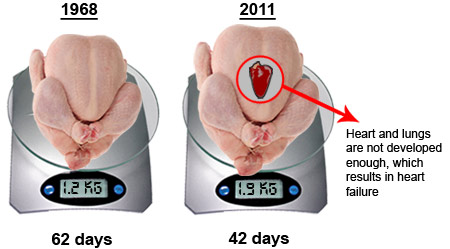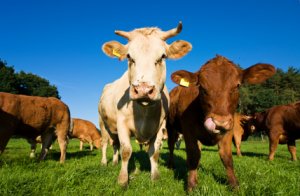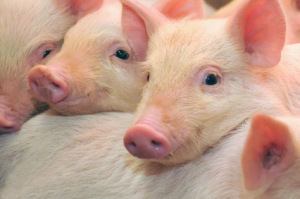How Do You Know if Geass Fed Chicken Is Bad
Popping into the shop for milk, eggs, meat and poultry is not what information technology used to be. You now become free-range, organic, grain-fed, grass-fed – the list goes on. What does it all mean and how do you know if you lot're getting the real deal?
An increasing number of people are asking questions about the food they buy: where does it come from, how has it been produced, how healthy is it really, does it contain antibiotics, growth hormones, pesticides or fertilisers, and how much corruption and suffering have animals had to suffer for us to have food on our plates?
The roughshod practices surrounding some of the "mill farming" (the mass production of livestock to provide food at lower costs to consumers) is a highly controversial and emotive topic betwixt animal rights advocates, environmentalists, farmers and corporations. It is a particularly thorny issue for a country such every bit South Africa which has millions of starving people to feed.
The contempo Supreme Poultry frozen chicken scandal (where it was revealed that sometime chicken had been injected with brine, repackaged and sold with a new expiry date; and some chickens reportedly had been treated with chlorine to reduce bacterial load) has non just highlighted the urgent need for improved nutrient regulation and consumer protection, it also triggered a new interest in organic and gratis-range livestock. SA's main source of protein
For many Due south Africans, chicken forms an integral role of their nutrition. In fact, a total of 1 billion broiler chickens (chickens bred specifically for meat production) are raised in South Africa each twelvemonth and around 18 one thousand thousand birds are slaughtered for their meat each week. In order to supply such a huge demand for meat, chickens are now genetically modified and pumped full of drugs to make them grow faster and larger.
Co-ordinate to Pity in Globe Farming SA, in 1968 South Africa, broilers were slaughtered at 62 days, weighing 1.2kg. Today, they are slaughtered at 42 days, weighing one.9kg. The birds grow so chop-chop that their hearts and lungs are not adult well plenty to support the residue of the body, resulting in center failure and tremendous death losses.

The chickens also become crippled considering their legs can't support the weight of their bodies. About one tertiary of them suffer agonising ammonia burns on their feet as a event of spending their brusk six-calendar week lives on faeces-saturated litter. Furthermore, they are in overcrowded conditions and in lodge to foreclose them from pecking themselves and others their beaks are seared off.
'Battery hens'
The plight of commercial egg-laying hens, or then-chosen "bombardment hens" (hens bars in small bombardment cages for the elapsing of their short lives) looks no improve. By 2012, the standard battery cages for laying hens will be banned for their cruelty throughout Europe. Yet, in South Africa, 22 million laying hens remain trapped in a infinite assart of less than an A4 sheet of paper - for life. Currently only 3 percent of laying hens are complimentary-range in S Africa.
Craven may be the main source of protein consumed in South Africa, merely the other livestock similar cattle, sheep and pigs have not escaped the cruelties of mill farming.
It is truthful that costless-range and organic farming are far more costly than conventional farming (more labour intensive, lower yields and college risks) and that the technological advances in manufactory farming ensure a constant supply of affordable animate being protein. Nonetheless, even if animal welfare is of no concern to you, yous should be worried most the quality of meat that y'all are consuming and the added growth-hormones, chemicals, pesticides and antibiotics, which could exist harmful to your wellness.
No official legislation in SA
Identifying authentic gratis-range and organic produce in Southward Africa can be tricky for consumers, as there is no official legislation in identify for free-range or organic farming in South Africa.
Says Kevin Lovell, CEO of the South African Poultry Association (Sapa): "'Free-range' equally a poultry concept is not currently fully covered by law in South Africa. There is a limited grade of control through the current egg packing regulations nether the control of the Department of Agriculture, Forestry and Fisheries (DAFF). The DAFF is however very close to finalising a set of free-range regulations for both eggs and poultry meat. We have had an opportunity to make inputs into these regulations as accept the National SPCA and other interested bodies. They are based on the Britain Liberty Foods organization and carry our full support."
Lovell explains that Sapa members currently take to conform to the Sapa Code of Practice (CoP) which specifies what constitutes "free-range" in reasonable detail. "This CoP is beingness updated and the new version, with some amendments to the 'gratuitous-range' requirements will hopefully become effective this year. One time the State publishes its regulations they will supersede our CoP equally we exercise not have the force of law. For our customers who set their own standards [such as Woolworths] their private standards cannot be lower than that set by the State but may be college."
When it comes to "organic" the waters are a bit murkier than with "free-range", as at that place are multiple definitions of the term "organic", says Lovell.
At nowadays the South African law governing organic farming is all the same in draft grade. Co-ordinate to Lovell, DAFF is busy with regulations in this regard merely information technology might be some time before these are promulgated. "In the interim there are only the private standards of the various organic certifying bodies." These certifying bodies mostly attach to European Matrimony requirements to certify Southward African organic farmers.

What is the difference between organic and free-range?
All organic animals are free-range, withal all free-range animals are not necessarily organic. All free-range animals alive natural lives, roaming on the land, interacting with one another and eating just plant-based foods. However, animals classified as free-range, non organic, may be treated past conventional veterinary methods when sick. In addition, while free-range animals eat but constitute-based foods, these are not necessarily organically produced, and may include approved artificial additives.
According to Jeanne Groenewald, the owner of Elgin Complimentary Range Chickens (the largest independent complimentary-range chicken farming operation in South Africa), "complimentary-range" doesn't necessarily hateful drug-free. "The use of antibiotics is common practise in farming, because information technology's an easy option and delivers excellent results.
"My chickens are drug-free, we use no antibiotics, simply if we practise get a sick chicken, we will medicate with assistance of a consulting vet and withdraw medicine at least ten days before slaughter – the normal standard is 5 days, we double it!"
Costless-range too does not ever mean that the animal has been in an open surface area its whole life. Information technology may simply mean they were in a restricted area and let out into that open surface area at one time during their life.
"Nosotros believe in humane farming practices," says Groenewald. "Our pasture-raised chickens roam freely on farms where they are free to express near all their natural behaviours. And just every bit nature intended, y'all won't discover any animal by-products, antibiotics or growth promoters in whatever of our chickens."
According to Groenewald the simply mode to meet whether animals are treated humanely is to visit the subcontract. "I have no problem showing guests effectually on our subcontract, but in that location is no way that commercial farms will permit visitors in. If y'all don't want someone on your farm, what are you lot hiding?"
Definition of free-range
The first free-range eggs were introduced onto the shelves of Pick 'n Pay and Woolworths in 1991, and in 2004 Woolworths banned all bombardment eggs from its shelves. Eggs that are non labelled "free-range" or "barn" are from caged hens.
It is important to note that free-range eggs from pastured chickens are quite different in terms of their egg yolk colour and egg shell strength. Chicken eggs are also much more nutritious when the poultry are able to run around outside eating plenty of bugs and grass versus eggs from confined grain fed chickens.
The first free-range broiler (meat) chickens became bachelor in supermarkets in 2004 and in 2007 Pick 'northward Pay were the first supermarket to launch free-range pork. (In Due south Africa, 2.1 million breeding sows remain confined in metal cages preventing whatever movement forwards, backwards or sideways, and their piglets are reared in barren sheds on factory farms – eventually condign our ham and salary.)
Woolworths defines "costless-range" as livestock that has the freedom to roam the outdoors (east.k. in gratis-range egg production, the hen is non kept in a cage) and that is housed in a barn with openings assuasive complimentary animal movement.

Definition of organic
In 1991, Woolworths were the first SA retailer to stock various fruit and vegetable ranges. Soon after they introduced organic meat (such as various beefiness and lamb cuts) and a range of organic dairy products.
"Organic would imply that not only are the animals reared on pasture that has no pesticides etc just in addition, the food given to the animals has been grown in pesticide-complimentary conditions and without unnatural chemical pesticides and growth promoting agents in the soil," says SA representative for Compassion in Globe Farming, Louise van der Merwe.
Woolworths add: "Organic livestock are fed a diet consisting of certified organic feed, accommodated in a free-range manner with costless access to the outdoors and treated only with approved homoeopathic remedies."
What is the difference between grain-fed and grass-fed?
There's a lot of confusion surrounding grass-fed vs. grain-fed. Grass-fed animals alive in pastures rather than feedlots. "Grass-fed" or "pasture-raised" oftentimes ways that animals were likely raised without the use of antibiotics and hormones. Also, their feed is typically not made with animal by-products.
Animals raised in feedlots are fed diets specifically designed to fatten them up as quick and as cheap as possible. The main feed that non-organic, non-grass-fed animals get is genetically modified grain and soy.
Most South African beef is grain-fed, which ways the cows are grass-fed for a short fourth dimension (differing from producer to producer) then moved into feedlots. The cow's alkaline digestive organization is naturally suited to grass whereas the unnatural corn diet negatively affects the cow's digestive arrangement, making frequent use of antibiotics unavoidable.
Also, synthetic growth hormone is given to near (though not all) grain-fed cows to achieve slaughter weight faster, whereas cows are given hormones to increment their milk supply.
While antibiotics are occasionally needed by grass-fed cows, this beef has been shown to be nutritionally superior to grain-fed. Information technology has less total fat, higher levels of heart-salubrious omega-iii fatty acids and higher levels of another type of fat, called conjugated linoleic acrid, which is idea to reduce heart disease and cancer risks.
Conclusion: what should you lot do?
Many retailers practice not inquire for a thorough authentication programme before taking on a supplier and many shops could at any given time take unproven product on their shelves.Information technology is important to check whether your retailer has an authentication programme in place and that their suppliers are externally audited on a regular ground. It is besides important to bank check whether their products are free of antibiotics and hormones.
Empower yourself past asking the correct questions from your retailer and enervating satisfying answers. Also check out the farmers' markets and local suppliers in your expanse. Soon, in Apr 2011, the Consumer Protection Act volition kick in, which will requite South African consumers the power to challenge suppliers and farming practices. However, it will only be effective if consumers are proactive and need transparency nigh the style that their nutrient was produced.
(Sources: http://www.ciwf.org.uk; www.mayoclinic.com; www.freerangechickens.co.za; www.woolworths.co.za; world wide web.HealthCastle.com; www.animal-voice.org, http://www.woolworthsholdings.co.za/, http://www.thedailygreen.com; world wide web.sapoultry.co.za; www.bbc.co.uk)
Source: https://www.news24.com/health24/diet-and-nutrition/food-safety/free-range-organic-grass-fed-do-you-know-what-youre-eating-20120721
0 Response to "How Do You Know if Geass Fed Chicken Is Bad"
Post a Comment